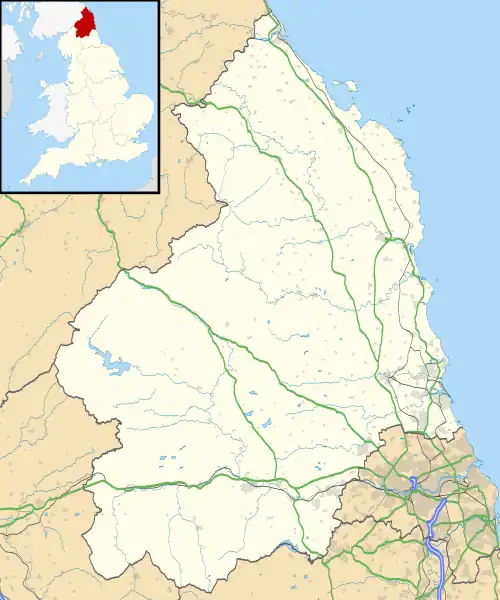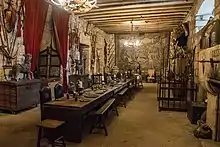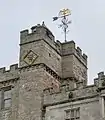| Chillingham Castle | |
|---|---|
 The north front | |
 Location within Northumberland | |
| General information | |
| Type | Castle |
| Location | Chillingham, Northumberland, England |
| Coordinates | 55°31′34″N 1°54′18″W / 55.526°N 1.905°W |
| Construction started | 12th century |
| Owner | Sir Humphry Wakefield, 2nd Baronet |
| Other information | |
| Number of suites | 8 |
| Website | |
| chillingham-castle | |
Chillingham Castle is a medieval castle in the village of Chillingham in the northern part of Northumberland, England. It was the seat of the Grey and Bennett (later Earls of Tankerville) families from the 15th century until the 1980s, when it became the home of Sir Edward Humphry Tyrrell Wakefield, 2nd Baronet, who is married to a member of the original Grey family.
A large enclosed park in the castle grounds is home to the Chillingham cattle, a rare breed, consisting of about 130 head of white cattle.[1]
The castle is a Grade I listed building.[2] In addition to the castle itself, a number of structures on the grounds of the castle are listed Grade II on the National Heritage List for England. These include the West Lodge and gateway,[3] the garden wall to the west,[4] the gateway and garden wall to the north,[5] the gateway and garden wall to the south east,[6] and the garden wall to the west.[7]
A pair of urns in the Italian Garden are also listed Grade II.[8]
History

The castle was originally a monastery in the late 12th century. In 1298, King Edward I stayed at the castle on his way to Scotland to battle a Scottish army led by William Wallace. A glazed window in a frame was specially installed for the king, a rarity in such buildings at the time.
The castle occupied a strategically important location in medieval times: it was located on the border between two feuding nations. It was used as a staging post for English armies entering Scotland, but was also repeatedly attacked and besieged by Scottish armies and raiding parties heading south. The site contained a moat, and in some locations the fortifications were 12 feet (3.7 metres) thick.
The building underwent a harsh series of enhancements, and in 1344 a Licence to crenellate was issued by King Edward III to allow battlements to be built, effectively upgrading the stronghold to a fully fortified castle, of quadrangular form.

Anne of Denmark, Queen of Scotland, and her children stayed in the castle on their way to London on 6 June 1603.[9] In 1617, James I, whose reign unified the crowns of England and Scotland (James I of England was also James VI of Scotland), stayed at the castle on a journey between his two kingdoms. As relations between the two countries became peaceful following the union of the crowns, the need for a military stronghold in the area declined. The castle was gradually transformed; the moat was filled, and battlements were converted into residential wings. A banquet hall and a library were built.
In the 18th and 19th centuries, the grounds underwent landscaping, including work carried out by Sir Jeffry Wyattville. The once extensive park is now under a separate ownership from the castle.[10]
The Prince and Princess of Wales stayed at Chillingham Castle en route to Scotland, in 1872.[11]

During the Second World War, the castle was used as an army barracks. During this time, much of the decorative wood is said to have been stripped out and burned by the soldiers billeted there. After the war, the castle began to fall into disrepair. Lead had been removed from the roof, resulting in extensive weather damage to large parts of the building.
The castle and estate remained linked with the Earls of Tankerville until Peter Bennett, 10th Earl of Tankerville, succeeded in 1980. Soon after this, the landed estate was broken up and sold.[12]
In 1982, the castle was bought by Sir Humphry Wakefield, 2nd Baronet, whose wife Catherine is descended from the Greys of Chillingham, and Wakefield set about a painstaking restoration of the castle.[10]
In 1997, the castle was used as a filming location for the film Elizabeth, featuring as Leith Castle and as the hunting lodge.[13] The fibreglass fireplaces from the film remain in the great hall, covering 18th-century white marble fireplaces from the demolished Wanstead House in east London.[14]
As of 2020, sections of the castle are open to the public including for late-night ghost tours, and eight apartments within the castle and its outbuildings are available for holiday rentals.[10]
Chillingham's ghosts

The current owners market the castle as being the most haunted castle in Britain.[15][16] It has been visited by the Most Haunted TV show.[17] The most famous ghost of the castle is the "blue (or radiant) boy", who according to the owners used to haunt the Pink Room in the castle.[18]
Chillingham Castle was the subject of episode 2 of the popular "How Haunted?" podcast.
In literature
In the novel The Bride of Lammermoor (1819) by Sir Walter Scott, Chillingham Castle is singled out as a last refuge for an ancient breed of Scottish cattle. The castle and cattle served as inspiration for Eva Ibbotson's 2005 children's book, The Beasts of Clawstone Castle.[19][20]
Chillingham Castle is the setting for the 2019 murder-mystery novel “Ryan’s Christmas” by LJ Ross.
Gallery
 The south front
The south front Inside the courtyard
Inside the courtyard Italian garden from the battlements
Italian garden from the battlements.jpg.webp) Chapel window
Chapel window.jpg.webp) Chillingham cattle
Chillingham cattle Statue of Viscount Gough
Statue of Viscount Gough 'Bat' weather vane on top of castle
'Bat' weather vane on top of castle
See also
References
- ↑ Stables, Daniel (16 September 2021). "A British beast rarer than the panda". BBC Future. Retrieved 19 September 2021.
- ↑ Historic England, "Chillingham Castle (1042387)", National Heritage List for England, retrieved 31 May 2020
- ↑ Historic England, "West Lodge and gateway to Chillingham Castle (1042394)", National Heritage List for England, retrieved 31 May 2020
- ↑ Historic England, "Garden wall to west of Chillingham Castle (1042388)", National Heritage List for England, retrieved 31 May 2020
- ↑ Historic England, "Gateway and garden wall to north of Chillingham Castle (1232691)", National Heritage List for England, retrieved 31 May 2020
- ↑ Historic England, "Garden wall and gateway south east of Chillingham Castle (1232716)", National Heritage List for England, retrieved 31 May 2020
- ↑ Historic England, "Garden wall to west of drive circa 100 yards north west of Chillingham Castle (1370908)", National Heritage List for England, retrieved 31 May 2020
- ↑ Historic England, "Pair of sandstone urns in the Italian Garden, Chillingham Castle (1232847)", National Heritage List for England, retrieved 31 May 2020
- ↑ HMC Salisbury Hatfield, vol. 15 (London, 1930), p. 126.
- 1 2 3 Duncan, Fiona (7 December 2005). "Britain: As if to the manor born (part 2)". The Daily Telegraph.
- ↑ "The Prince and Princess of Wales in Edinburgh". Berwickshire News and General Advertiser. 22 October 1872.
- ↑ Chillingham, Northumberland County Council, accessed 13 January 2023
- ↑ "Elizabeth : 1997". Movie Locations. Retrieved 9 January 2020.
- ↑ Wakefield, Humphry. Chillingham Castle Room & Grounds Guide. Chillingham Castle.
- ↑ "Ghosts". Chillingham Castle. Archived from the original on 9 October 2017. Retrieved 9 October 2017.
- ↑ Wakefield, Mary (29 October 2004). "The ghosts of a chance". The Daily Telegraph. Retrieved 9 October 2017.
- ↑ Smith, Ian (12 April 2007). "Castle's ghostly reputation leads to expansion plans". Berwick Advertiser. Archived from the original on 9 October 2017. Retrieved 9 October 2017.
- ↑ Campbell Dixon, Anne (24 June 2000). "Northumberland: Castle's knight in shining armour". The Daily Telegraph. Retrieved 9 October 2017.
- ↑ Whetstone, David (17 May 2005). "Eva just gets better". The Journal. Newcastle Upon Tyne. Archived from the original on 15 February 2015. Retrieved 15 February 2015.
- ↑ "Obituary: Eva Ibbotson". The Scotsman. Edinburgh. 25 October 2010. Retrieved 15 February 2015.
